|
Energy
Security at BOP A griculture sector contributes nearly 20% of India’s GDP and 11% of total exports, provides employment to more than 55% of the country’s workforce and livelihood security to about 650 million people. The country is a net exporter of agricultural products for many years now. The remarkable progress in agriculture has also enabled the country to be food secure. All these underscore the achievement and crucial role of agriculture in the overall economic and social well being of the country.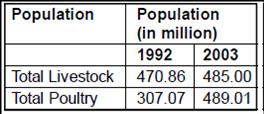
On the other hand, the livestock sector has a very important role in Indian farming system. They not only provide milk and meat but also provide farm yard manures, wool, egg etc. Besides, they are extensively used in agriculture for draught purpose as well for transport purposes particularly in rural area. The increase in cattle population, particularly in poultry population, clearly justify its viability Though the statistical data
paints the glorified picture of Indian agriculture sector but majority
of farmers are still seen as poor. The associated risk of agriculture
due to uncertainties are growing faster than the agriculture return.
Thus, more than the productivity, profitability now- a-days has become
the only evaluation criteria for success. Energy Availability and Sinking Profitability: India, in the last 20 years has addressed almost all issues, from policy change to capacity building of farmers; from advance research to IPR of indigenous species to ensure productivity/profitability enhancement, but energy security issue had never taken central stage. Dr Nawab Ali, DDG(Engg.), ICAR has shown a strong relation between energy availability and productivity (as shown in the table). Even though short term people friendly policies, such as subsidized/free electricity for farmers, control over diesel price etc has reduced the financial burden of farmers to some extent, it has always reduced the urgency of promotion/ adoption of Renewable Energy Technologies (RET) in agriculture sector. Though both Central and State Govternments have tried to promote RETs by providing capital subsidy from MNRE - soft loan through IREDA/ Nationalized Bank and several exemptions / reductions on duties / taxes but due to subcritical number of successful pilot demonstration, we have hardly harvested any potential of power generation from RETs to help farmer by ensuring access to reliable and affordable energy. Source: Directorate of Economics & Statistics, Govt. of India Source:
Department of Animal Husbandry, Daring & Fisheries, Govt. of India Farm Waste as Source of Energy:
The current global primary energy need
is 10 billion TOE / year, whereas solar energy that is biologically
absorbed in biomass is approx 150 billion TOE /year. India has 141
million hectares of arable land and agricultural/horticultural output is
close to 800 million tons, which generates nearly 700 million tons of
waste. Hence, even after deducting approximately 450 million tons of
waste which is used as fodder, 250 million tons of surplus agricultural
waste could be used for Biomass Power Generation. As per Department of
Animal Husbandry, Govt. of India, dairy population increases from 307
million (1992 census) to 489 million
On the other hand 70 million
hectares of forest land result in waste can bring more solution to
Indian farmer if used properly. Assuming forest stock of 100 cum/hectare
and "dead & fallen" waste generation of 5% per annum we can have an
annual generation of forestry waste of 350 million cum (280 million MT).
Though there are limited or no institutional mechanisms for collecting
this forest waste and therefore only a small fraction of this is put to
productive use (household cooking fuel or fuel wood). Assuming annual
growth of 3 cum/year, there would be 210 million cum (or 160 million MT)
annual growth in "forest stocks". There could be some institutional
mechanisms for selective & sustainable utilization of some of the growth
in "forest stocks" for Biomass Power generation, particularly in tribal
areas. Much Talked Model Tested in Bundelkhand:
Since the last one decade, energy professionals across India, are trying
to demonstrate the institutional and financial viability of small RET
based power plant and also trying to link it with productive load to
ensure local value addition so as to boost up the intra village economy.
Last three years, Development Alternatives has started work with
community to demonstrate community owned, community managed off-grid
Biomass Gasifier based power plant. 14 community members selected
through open gramshabha meeting, including 4 women members, to form the
management body, called Village Energy Committee (VEC). It took us over
2 years, to develop the ‘WE’ feeling among the entire community. A
homogeneous rule has evolved as an outcome of series of small group
discussion, monthly gramshabha meeting and 2 group exposure visits. For
almost the last one year Radhapura village of Pichor block of Shivpuri
district (MP) is generating energy and consuming it for local value
creation. Out of 87 household 60 household has taken paid-domestic
connection. As a connection fee of Rs. 500 per family has been collected
by community and kept aside into
This initiative has developed and introduced a delivery mechanism to provide irrigation services to farmers. In the last Rabi season (Nov 09 to March 10), VEC has supplied energy to four farmers - those who able to purchase two HP mono-block AC pump and also delivered irrigation services to 14 farmers who could not manage the initial capital. Considering cost of diesel based irrigation as a baseline, VEC has developed a specific tariff structure as shown in above table. For the ease of management and also to meet the specific crop wise irrigation need, VEC has promised to provide energy/energy services for at least 4 hrs/day and at least five to six such services per crop to maximize crop productivity. As compared to diesel based irrigation through 5 HP mono-block pump, which cost approx Rs. 90 to Rs 120 per Ac, RET based irrigation needs approx Rs. 60 to Rs. 80 per Ac. Based on the last one year’s experience we have learned that agriculture consumes approx 54% generated energy where as enter-prise and domestic consumption is 28% and 18% respectively. Presently community institution has developed to such levels that rolling back possibility is almost zero. But the main challenge of the initiative is to demonstrate financial viability of the model particularly in the lean (Zaid season) or no agriculture season. Developing and managing more productive load, is the only area where the community is mainly focusing and planning to set-up enterprise to ensure post harvest value addition. Ensured supply of biomass, to power plant, from nearby villages, is another issue, as dependency on natural vegetation (particularly of high generating shrub spices) is ever increasing to meet the domestic and livelihoods demand. To address this issue the VEC has taken major plantation initiative. VEC has sensitized local community and has promoted fuel forestry by supplying Leucaena Leucocephala (fast re-generating shrubs) seed and sown in 10 Ha land. Replication Strategy: There is every possibility that under favorable agro-climatic condition, any village can generate enough energy demand, round the year to ensure affordable irrigation and post harvesting value added activities. The proposed replication strategy envisaged bigger role for progressive farmers as a potential investor of such social enterprise. These farmers (or CIG) will also become the major consumer of energy/energy service to enhance productivity. On the other hand medium/small farmers and potential entrepreneurs will act as major consumer energy to ensure financial viability of this proposed enterprise. The poorest of the poor and the landless, in this development process will carry out energy plantation (mainly through waste land development initiatives) and will ensure un-interrupted supply of biomass to ensure their livelihoods. q Manoj Mahata skgupta@devalt.org Back to Contents |
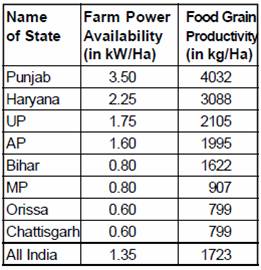
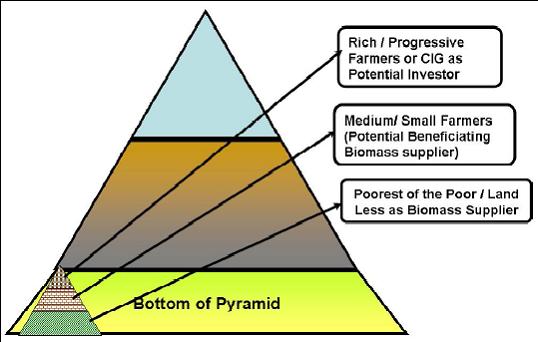
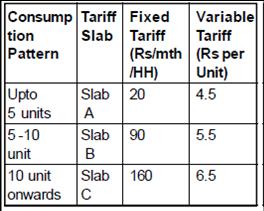 (2003
census). As per the national master plan for development of
Waste-to-Energy, Ministry of New and Renewable Energy (MNRE) estimates
that the total power generation potential from waste is 864 MW.
(2003
census). As per the national master plan for development of
Waste-to-Energy, Ministry of New and Renewable Energy (MNRE) estimates
that the total power generation potential from waste is 864 MW.
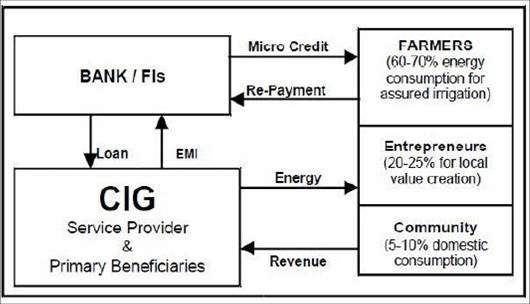
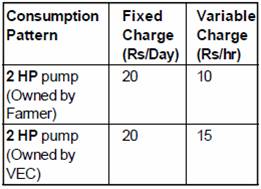 VEC’s
bank account as a security deposit. To ensure financial viability VEC
has introduced consumption based tariff model as shown in the table. The
tariff model not only motivates the community to adopt CFL and other
energy efficient electrical implements but also reduce the energy
expenditure for non productive loads. It also generate basic minimum
revenue, as there is hardly any seasonal load fluctuation, necessary for
purchasing biomass, carry out periodic maintenance. The revenue, earned
against domestic supply is not enough to pay operator’s salary of Rs.
1,800 per month. Realizing this, VEC decided to collect 10 rupees from
each household towards providing for street lights. To optimize the
expenditure and also to ensure consumer’s satisfaction VEC agreed to
provide minimum 3 hrs of supply (in the evening) for at least 25 days
per month.
VEC’s
bank account as a security deposit. To ensure financial viability VEC
has introduced consumption based tariff model as shown in the table. The
tariff model not only motivates the community to adopt CFL and other
energy efficient electrical implements but also reduce the energy
expenditure for non productive loads. It also generate basic minimum
revenue, as there is hardly any seasonal load fluctuation, necessary for
purchasing biomass, carry out periodic maintenance. The revenue, earned
against domestic supply is not enough to pay operator’s salary of Rs.
1,800 per month. Realizing this, VEC decided to collect 10 rupees from
each household towards providing for street lights. To optimize the
expenditure and also to ensure consumer’s satisfaction VEC agreed to
provide minimum 3 hrs of supply (in the evening) for at least 25 days
per month.